Key takeaways:
- Narrative reclamation empowers individuals to reshape their stories, fostering emotional healing and connection.
- Storytelling in workshops builds belonging and encourages deeper engagement, creating an environment for shared learning.
- Creating a supportive atmosphere, through comfortable settings and active listening, enhances participant openness and connection.
- Personal narrative sharing, bolstered by vulnerability and authenticity, inspires others and promotes a sense of community.
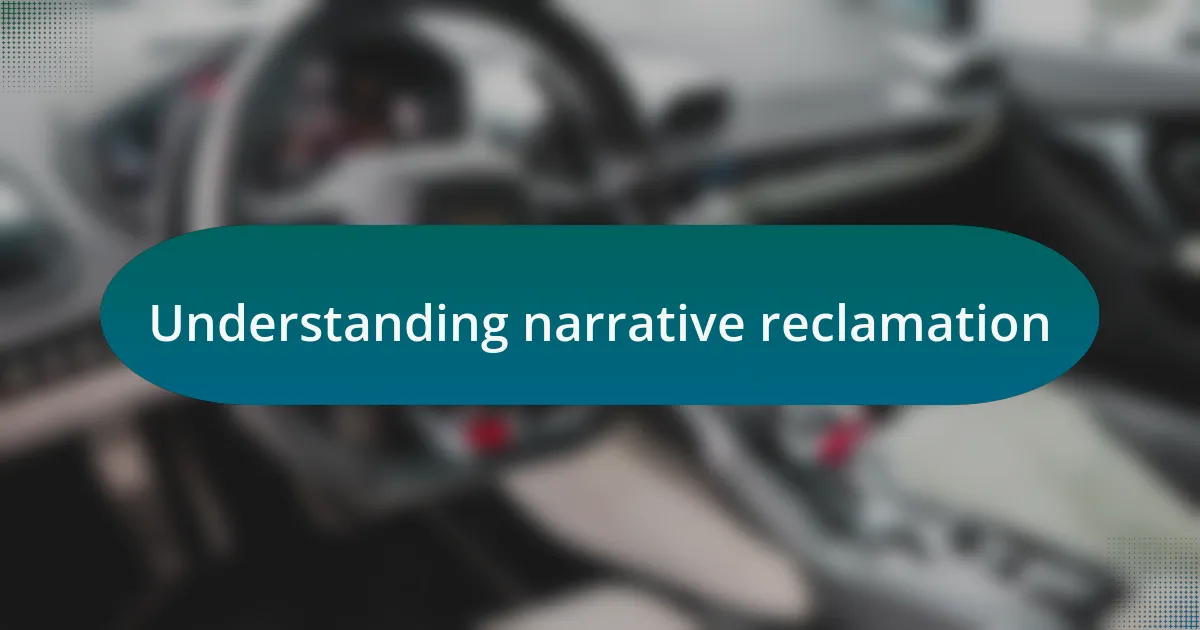
Understanding narrative reclamation
Narrative reclamation is the powerful process of taking back control over one’s own story, particularly for those whose voices have been marginalized. I remember leading a workshop where a participant shared how her experiences had been dictated by others for too long. It was transformative to witness her shift from being a passive character in her own life to becoming the author of her own narrative.
When we engage in this process, we challenge preconceived notions about our identities and experiences. I’ve seen firsthand how participants often feel a wave of relief when they realize they can reshape their stories. Isn’t it invigorating to think about how revisiting our narratives can open doors to new understanding and empowerment?
Moreover, narrative reclamation encourages emotional healing and connection. During one workshop, another participant expressed how sharing his story was not just about him; it was about inspiring others who felt trapped in their own narratives. It made me ponder—how many stories are waiting to be told, and how can sharing them create a ripple effect of change?
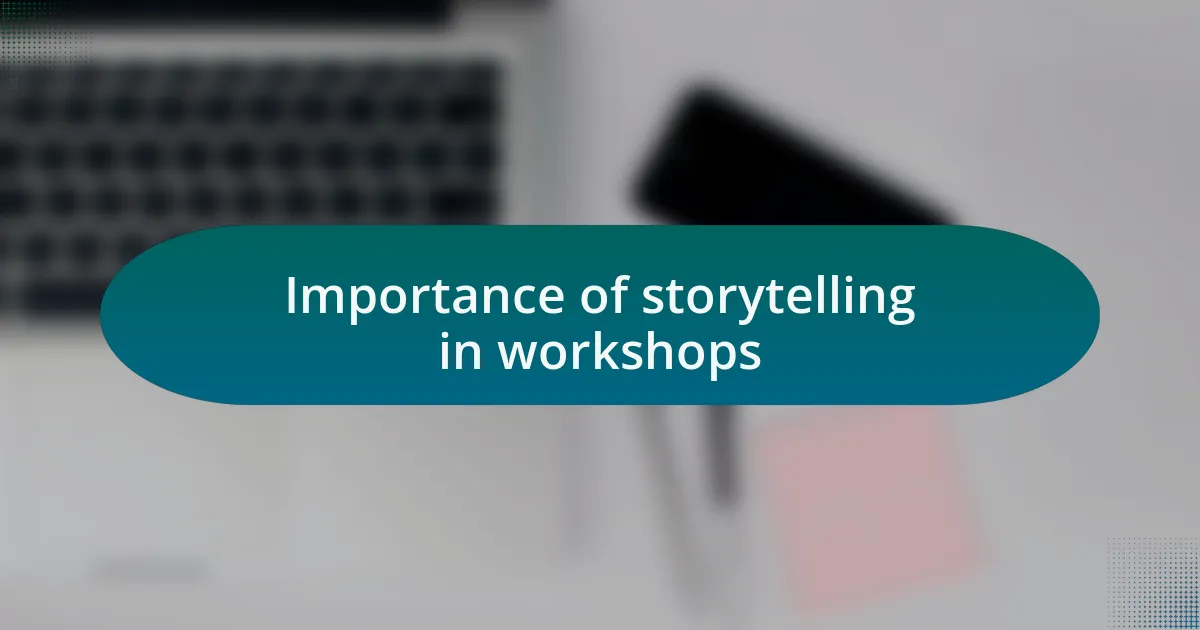
Importance of storytelling in workshops
Storytelling in workshops plays a crucial role in fostering a sense of belonging and connectedness among participants. I’ve noticed that when individuals share their narratives, it often sparks a chain reaction, encouraging others to open up about their experiences. One time, I facilitated a session where a few participants were initially hesitant to share. Yet, once someone bravely recounted their struggles, the room’s energy shifted dramatically, creating a safe space for all to express themselves.
In my experience, storytelling serves not just as a method of communication but also as a tool for learning. I recall a workshop where several tech professionals shared their personal journeys with failures and successes in their careers. Listening to their stories about navigating obstacles, I realized how those tales offered practical lessons. It made me wonder—how can we cultivate an environment where stories become learning opportunities for everyone involved?
Another important aspect is the emotional impact of storytelling, which helps participants connect on a deeper level. I once observed how a participant’s heartfelt narrative about their struggles with imposter syndrome resonated profoundly with many in the room. It highlighted for me how genuine storytelling can break down barriers and invite empathy, prompting us to reflect on our own journeys. Isn’t it fascinating how a simple story can hold the power to bridge gaps and foster understanding in a diverse group?
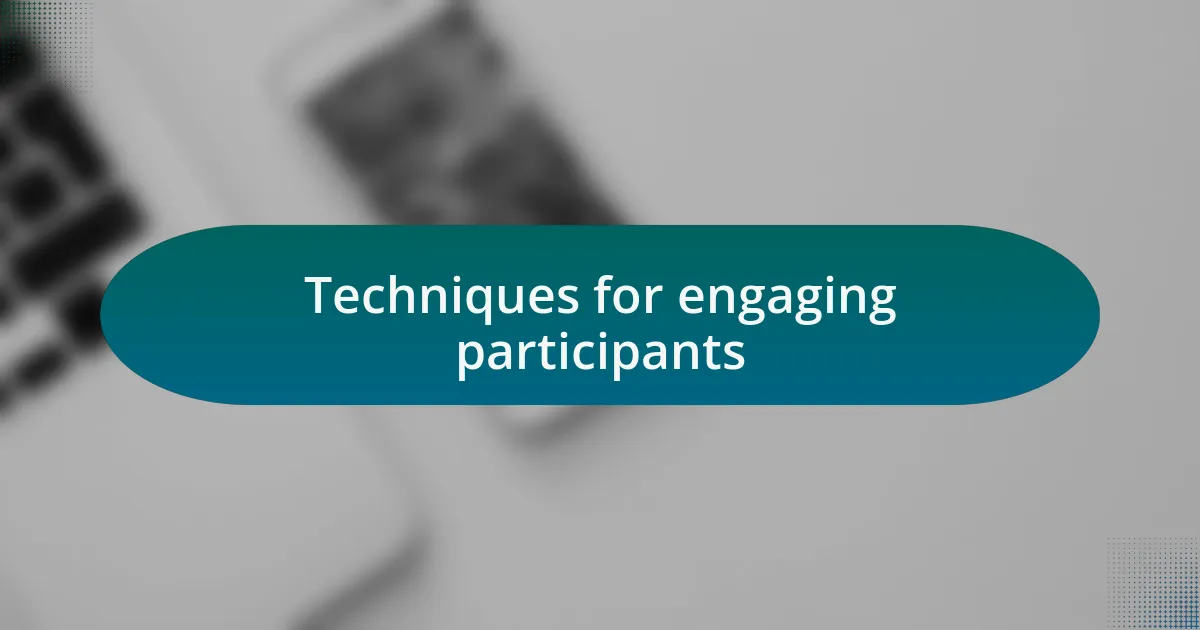
Techniques for engaging participants
Engaging participants in workshops often starts with creating a welcoming atmosphere. I’ve found that beginning with icebreaker activities can set a playful tone, allowing individuals to loosen up and feel more at ease. In one workshop, I used a quirky question—like what superpower they would choose—and the laughter that ensued sparked connections among participants. It was a reminder of how humor can break the ice and lay the groundwork for deeper conversations.
Another effective technique is to incorporate small group discussions. I vividly remember facilitating a session where participants were divided into pairs to discuss prompts based on their experiences in tech. Watching them lean in and genuinely listen to each other was enlightening. I believe that these intimate settings can foster trust and encourage voices that might otherwise remain unheard. How might we leverage these small moments to invite everyone into the narrative?
Finally, I like to use interactive elements such as live polling or visual storytelling tools. In one workshop, we utilized a digital tool that allowed participants to share their thoughts anonymously. The insights that emerged were both surprising and valuable, stirring discussions I hadn’t anticipated. This approach not only brought quieter participants into the fold but also provided a platform for a diversity of perspectives. How can we turn these techniques into a routine practice to keep participants engaged and involved?
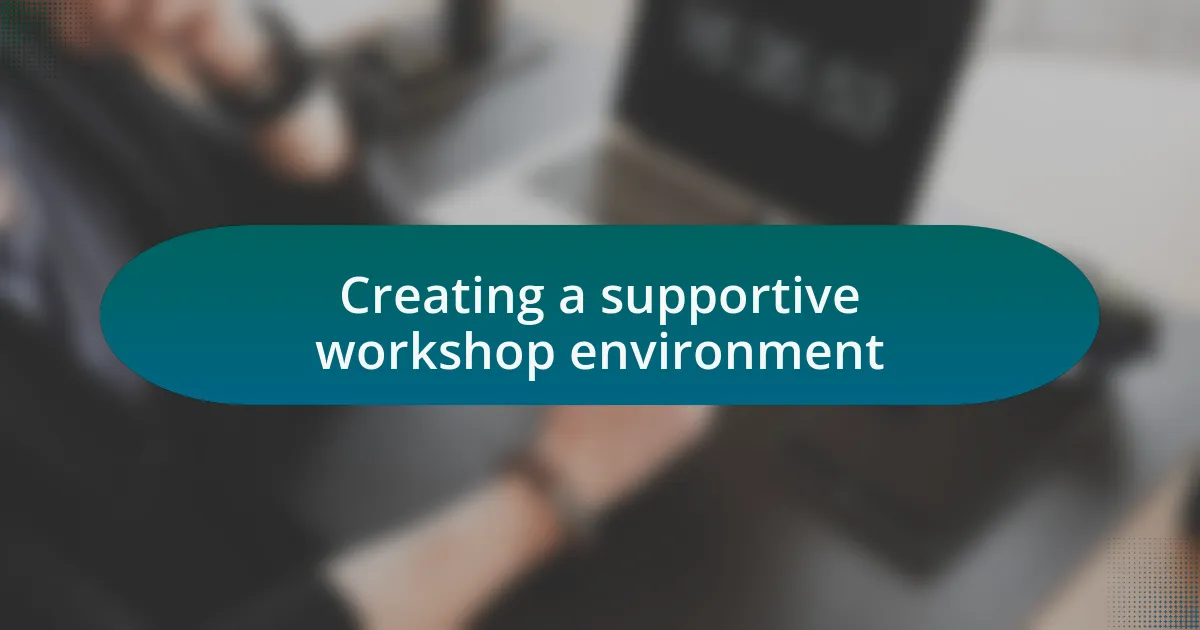
Creating a supportive workshop environment
Creating a supportive workshop environment hinges on the atmosphere we cultivate. I recall a workshop where I made it a point to set up the room with comfortable seating and warm lighting. This simple change made a world of difference, as participants felt more relaxed and open to sharing their thoughts. Who knew that the right environment could be as crucial as the content itself?
Another approach I’ve used is to incorporate check-in moments throughout the session. I remember a particular instance where I invited participants to share how they were feeling at various stages of the workshop. It was eye-opening to see how many felt validated when their emotions were acknowledged—whether it was excitement, anxiety, or curiosity. How often do we pause in our busy lives to truly check in with ourselves and others?
Listening is key to creating a space where everyone feels supported. During one workshop, I made it a point to actively listen without interruption whenever someone shared their story. Their experiences were rich and multifaceted, revealing insights that I had never considered before. I often wonder how many gems of wisdom we miss out on when we don’t genuinely listen. In fostering this culture of respect, we not only support our participants but also build a community that thrives on shared narratives.
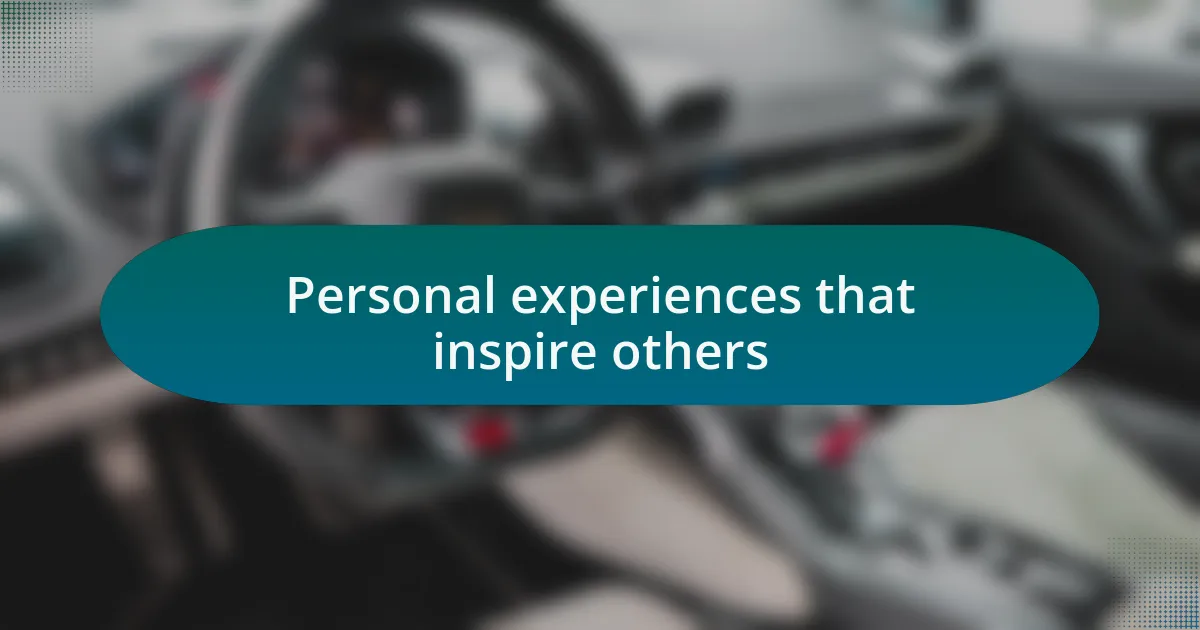
Personal experiences that inspire others
I remember a participant sharing her journey of overcoming self-doubt in one of my workshops. She described how she had felt invisible in her workplace, often sidelined during meetings despite having great ideas. Listening to her transformed the dynamic of the room; it reminded me how powerful personal stories can be. When we hear someone’s vulnerability, it not only inspires us but also encourages others to share their own journeys. Have you ever felt motivated by someone else’s struggle?
On another occasion, a tech professional recounted his experience of pivoting from a stagnant career to pursue his passion for coding. His authenticity struck a chord with everyone, igniting a spark of aspiration within the group. I could see faces light up as he encouraged them to take ownership of their paths, reminding us all that it’s never too late to reshape our narratives. How often do we allow ourselves to think about the possibilities that lie just beyond our comfort zones?
In sharing these personal stories, I’ve witnessed unexpected connections form between participants. One particularly touching moment was when two attendees exchanged contact details after bonding over shared struggles. It’s incredible to see how narratives can weave together, creating a tapestry of experiences that not only inspire but also empower others to reclaim their own stories. Have you ever felt a sense of camaraderie through shared experiences?
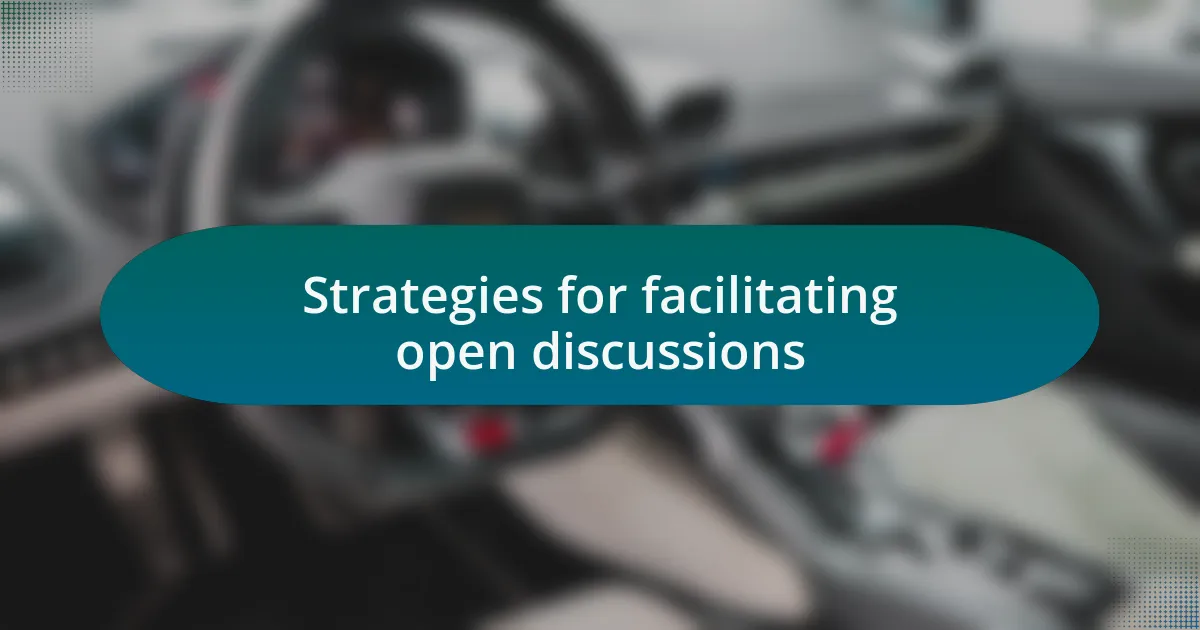
Strategies for facilitating open discussions
One effective strategy for facilitating open discussions is to create a safe space where participants feel comfortable sharing their thoughts. In a recent workshop, I rearranged the seating to foster more eye contact and interaction, which made a significant difference. Have you noticed how the arrangement of a room can influence the energy? It’s amazing how a circle can transform the atmosphere, creating a sense of equality and openness among participants.
Encouraging participants to ask questions instead of simply responding to prompts can also lead to richer discussions. I often introduce an icebreaker that invites everyone to share one question they wish to explore further. This approach not only sets a tone of curiosity but allows participants to guide the conversation organically. Have you ever found that your most profound insights came from questions rather than answers?
Finally, employing active listening techniques is essential for nurturing meaningful dialogues. During one session, I made it a point to paraphrase participants’ responses, which helped them feel heard and valued. It’s surprising how this simple act can lead to deeper connections. When was the last time you felt truly understood in a conversation? I’ve seen firsthand that when participants feel acknowledged, they are more likely to engage fully and share their own narratives.
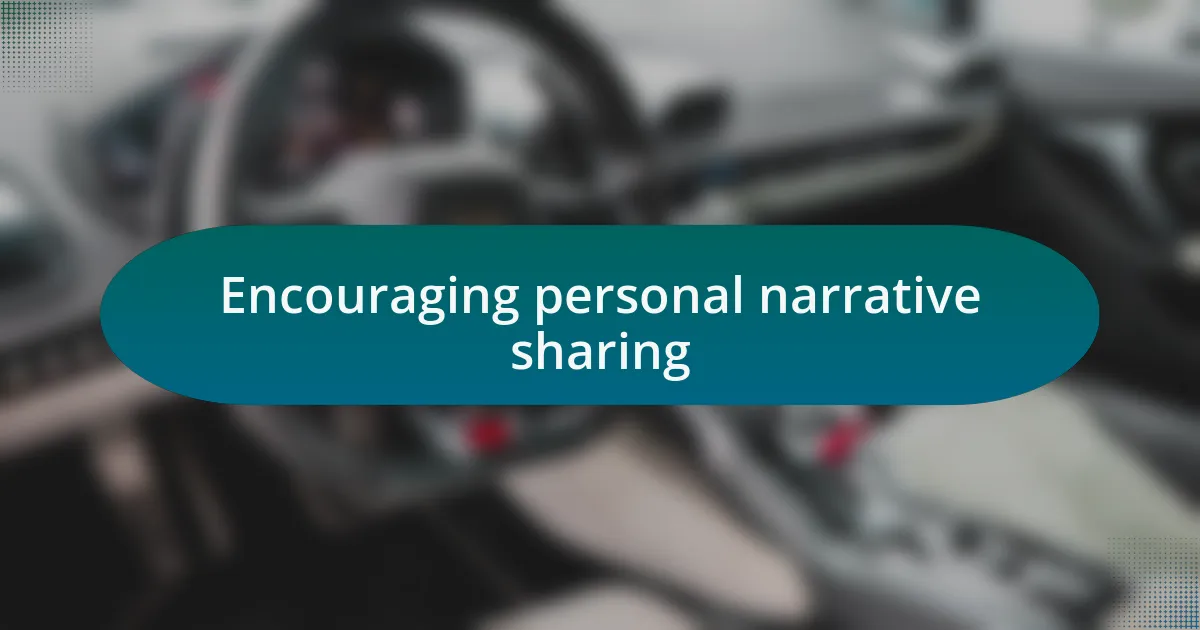
Encouraging personal narrative sharing
Creating a culture of personal narrative sharing often starts with vulnerability. In one workshop, I shared my own story about a challenge I faced in my career, which opened the floodgates for others. The room filled with stories of triumphs and struggles, each one unique yet deeply relatable. Isn’t it incredible how a shared experience can resonate so profoundly among diverse individuals?
I also emphasize the power of storytelling prompts to ignite sparks of creativity. For instance, I once asked participants to consider a moment that changed their professional trajectory. Watching them light up as they connected past experiences to present aspirations was energizing. Have you ever felt that rush of emotion when recounting a pivotal moment in your life? It’s moments like these that make sharing personal narratives feel not only safe but invigorating.
Finally, I encourage participants to embrace their authenticity by reflecting on the lessons learned from their experiences. In one instance, a participant shared how a failure taught them resilience, inspiring others to reframe their setbacks as growth opportunities. When we view our stories as tools for self-discovery, it creates an environment where everyone feels empowered to contribute. Isn’t it beautiful how personal narratives can transform our perspectives?